
Baltic Germans are ethnic German inhabitants of the eastern shores of the Baltic Sea, in what today are Estonia and Latvia. Since their resettlement in 1945 after the end of World War II, Baltic Germans have markedly declined as a geographically determined ethnic group in the region.

Otto von Kotzebue was a Baltic German naval officer in the Imperial Russian Navy. He commanded two naval expeditions into the Pacific for the purposes of exploration and scientific investigation. The first expedition explored Oceania and the western coast of North America and passed through the Bering Strait in search of a passage across the Arctic Ocean. His second voyage was intended as a military resupply mission to Kamchatka but again included significant explorations of the west coast of North America and Oceania.

Faddey Faddeyevich Bellingshausen or Fabian Gottlieb Benjamin von Bellingshausen was a Russian cartographer, explorer, and naval officer of Baltic German descent, who attained the rank of admiral. He participated in the first Russian circumnavigation of the globe, and subsequently became a leader of another circumnavigation expedition that discovered the continent of Antarctica. Like Otto von Kotzebue and Adam Johann von Krusenstern, Bellingshausen belonged to the cohort of prominent Baltic German navigators who helped Russia launch its naval expeditions.

Alexander Friedrich Michael Lebrecht Nikolaus Arthur Graf von Keyserling was a Baltic German geologist and paleontologist from the Keyserlingk family of Baltic German nobility.
Stackelberg is a surname, mainly known as the surname of a noble family of Baltic German descent. Notable people with the surname include:

Adolf "Ulf" Konstantin Jakob Freiherr Pilar von Pilchau was a Baltic German politician and regent of the United Baltic Duchy (1918).

The Baltic German nobility was a privileged social class in the territories of modern-day Estonia and Latvia. It existed continuously from the Northern Crusades and the medieval foundation of Terra Mariana.
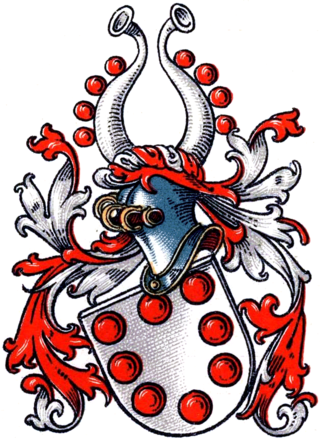
The Staël von Holstein family is a Baltic-German Baronial family originating from Westphalia.

Friedrich Wilhelm Rembert Graf von Berg was an Imperial Russian nobleman, statesman, diplomat and general of Baltic German descent. Berg was a count of the Austrian Empire and Grand Duchy of Finland and the 5th last man to be promoted General-Field Marshal in the history of the Russian Empire. He served as the Governor-General of Finland from 1854 to 1861 and the last Viceroy of the Kingdom of Poland from 1863 to 1874.
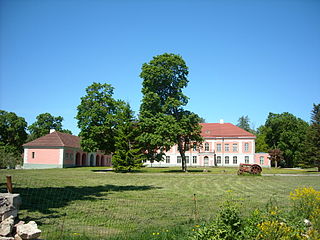
Rägavere is a village in Rakvere Parish, Lääne-Viru County, in northeastern Estonia.
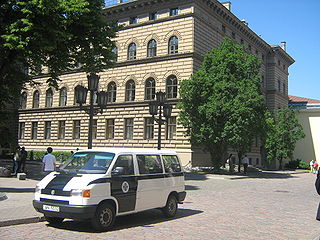
The Livonian Knighthood was a fiefdom that existed in Livonia. It was formed in 1561 by Baltic German nobles and disbanded in 1917 in Estonia, and in 1920 in Latvia. Like other Baltic knighthoods, the Livonian also had semi-autonomous privileged status in the Russian Empire.

Adam Johann von Krusenstern was a Russian admiral and explorer of Baltic German descent, who led the first Russian circumnavigation of the Earth in 1803–1806.
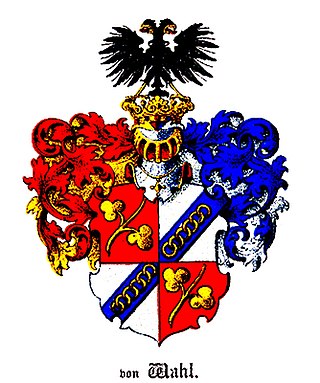
The Wahlfamily is a noble family originating in Scotland which later settled in the Baltic states.
Eduard Otto Emil Karl Adam Freiherr von Stackelberg was an Estonian chemist, landowner and politician who belonged to the Stackelberg family. As a chemist, he proposed a model for the periodic table in 1911. He was among the Baltic German landowners deported to Siberia, first by the Tsarist authorities and later by the Bolsheviks. Following World War I he lived in Germany. In 1927 he published a memoir.

Pontus Alexander Ludwig Graf Brevern-de la Gardie was a Swedish count, Baltic German nobleman, military officer and statesman of German, French and Swedish descent, in the service of the Imperial Russian Army who commanded the Kharkov and Moscow Military District form 1865 to 1869 and 1879 to 1888 simultaneously. He was also the chief of staff of the Petersburg Military District from 1862 to 1865.

Peter Paul Alexander von Baranoff was a Baltic German military officer and statesman. During the First World War, Baranoff was known for his investigations, most notably his investigation of fellow general Paul von Rennenkampf's actions during the Battle of Łódź.

Paul Andreas Edler von Rennenkampff was a Baltic German nobleman, military commander and Statesman in the service of the Imperial Russian Army. Rennenkampff was noted for his distinguished roles during the Suppression of the South Ossetians in 1830 and the Crimean War, especially during the Siege of Sevastopol.

The Rennenkampff family is a Baltic-German noble family. It is of Westphalian origin and originated in Osnabrück. They hold the title of Edler.
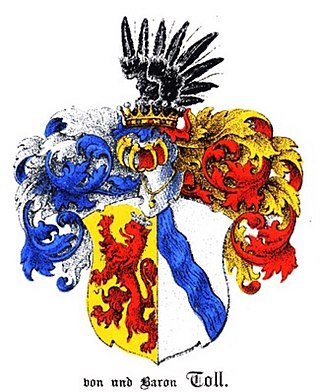
The Toll family was a Baltic German noble family of possible Hollandish origin. According to legend, the family's name originated from a castle near Leiden. The family held Swedish and Russian baronial and comital titles, Austrian baronial titles, Prussian, Oldenburgish, Finnish untitled noble status and also possibly belonged to Dutch nobility.




























